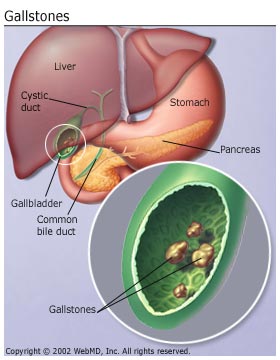Module 7: The ASEAN World of Medicine
Table of Contents
Reading Text & Presentation
7.3.3 Gallstones

(Source: http://www.webmd.com/digestive-disorders/gallstones retrieved 3/7/2014)
Found in the gallbladder, gallstones are hard, pebble-like deposits. They vary greatly in size; anything from 1mm to over 40mm.
The causes of gallstones vary, but there are two main types: Those composed of cholesterol, which are the most common, and those composed of bilirubin. People aged over 40, Native Americans, and Hispanics are more susceptible to gallstones. They are also more common in women, and sometimes run in families.
Cholesterol gallstones are not connected with cholesterol levels in the blood. Bilirubin gallstones occur in hemolysis (when red blood cells are being destroyed). Too much bilirubin in the bile can add to the formation of the stones which will have a darker colour and are called pigment stones.
Some of the possible causes of gallstone formation are; bone marrow or organ transplant, diabetes, gallbladder failure to empty bile (often during pregnancy), liver cirrhosis and biliary tract infections, medical conditions causing the liver to make too much bilirubin, rapid weight loss from low-calorie diets, and long-term intravenous feeding.
Gallstones are often identified during routine medical procedures with the patient never having any symptoms. The stones form slowly, and it’s only when a larger stone begins to block the cystic duct or common bile duct that pain in the middle to right upper abdomen occurs. It is known as biliary colic, and the pain or discomfort may go away if the stone moves. The pain a person feels will vary: in the right upper or middle upper abdomen; constant, sharp, cramping, dull; spreading to the back, below the right shoulder blade; fever; and yellowing of skin and whites of the eyes (jaundice). There may be other signs such as clay-colored stools or nausea and vomiting, or prolonged indigestion after eating foods high in carbohydrates and drinking dairy products.
A physician will usually conduct tests and prescribe various treatments. However, medication and homeopathic remedies are usually slow and the stones may well form again. In general, patients who have symptoms will need surgery. In the past gallbladder removal required invasive surgery, but nowadays the laparoscopic (keyhole) method is preferred using smaller surgical cuts.
